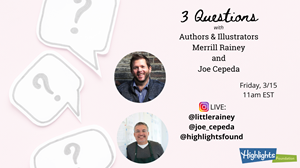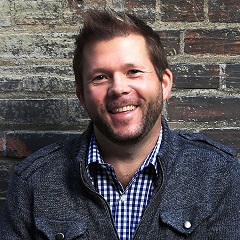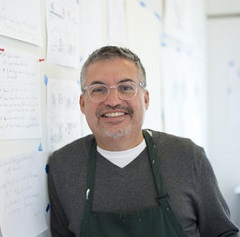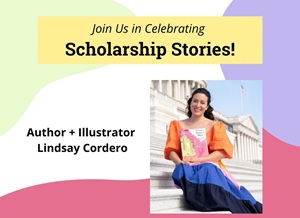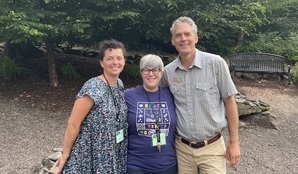Merrill Rainey and Joe Cepeda joined Highlights Foundation Social Media Manager Cat Galeano on Instagram Live to talk about their upcoming mini-course: Creating for Our Youngest Readers: Board Books, Concept Books and Novelty Books.
Watch the conversation below. (Please note: closed captions are being added to the video below. When they are finished, you can see them by hovering over the bottom of the video and choosing the “CC” icon.)
Full Transcript:
Cat:
A big hello to our Highlights Foundation family. We’re so happy to have you here with us. For those that may not know me, I’m Cat Galeano, my pronouns are she, her, and I’m the social media manager for the Highlights Foundation, joining you from Rochester, NY on the traditional lands of Seewanoy people. Apart from all the fun things I get to do at the Highlights Foundation, I am also a writer and a reader, who is very excited to be with our friends and faculty Merrill Rainey and Joe Cepuda, who will be teaching the upcoming two night mini Creating for Our Youngest Readers: Board, Novelty and Concept Books next week on March 18th and 20th.
Before we dive in, I just want to remind our viewers that joining in in any Highlights Foundation sessions, to do so with no hate, no harm and no harassment of any kind.
Now let’s get started. So my first question for you, for both of you, is–and feel free to jump in whoever wants to start first–is what’s one example of a board, concept or novelty book–either yours or not–that you loved, that did a great job of giving a child and caregiver an opportunity to connect. And how did that book accomplish that?
Merrill:
Joe, do you want me to go first or…
Joe:
Yeah, sure. Go ahead.
Merrill:
OK, alright. So, so for me this is a personal experience, but when my son–who’s now 14–was first born, obviously we’re in, we were in the middle of reading board books left and right. And the one that we’ve read and we’ll still read periodically is The Going to Bed Book by Sandra Boynton. And there’s not, I mean, there’s, there’s no bells and whistles through it. Nothing that spins, nothing that pulls, nothing that unfolds, but it was the, the experience. Obviously the artwork is super fun for a little to look at, but the way that Sandra wrote the book from an adult experience gave, it was nice connection because it was taking me back to those moments of what getting ready to bed was this big drawn-out adventure, of all these experiences that, that happened and you know. Going to bed, it takes at least an hour, I think in my house to get my kids to go to bed. So it’s like, some of those adventures that went on so I had a nice connection with it and experience with it. And then with the same thing as holding my son at an early age. So it was a nice kind of bonding moment, I guess.
Joe:
I don’t remember a specific book, but like Merrill, get you know, reading to my son when he when, he was trying to go to sleep was always a, somewhere between a joy and something else. But I remember Gorilla…Goodnight, Gorilla. That one was was a was a favorite that we liked. And I think it’s a board book, right? I, I’m, I’m not sure. But my experience actually is very recent in doing these books that I’ve been doing for the earliest readers. I was asked once to go to a kindergarten class who couldn’t go to the regular assembly at a school visit because they had different hours. And the teacher really wanted me to read one of my books. I believe it was I See. And so I went there, but before I even said the first words as I opened the page, THEY read the first word “I see,” and then as I turned the page, I never got a word in edgewise while everyone read. These kids just were just so excited to read to ME. I think that’s when I actually understood what these books are about. Learning to read and the power the first time you read a book by yourself.
Cat:
Yeah. I just kind of wanted to jump in to to both of you. Thank you for sharing that, that your experiences cause like I’m first generation. My parents are immigrants and so board books were sort of the very first thing they could read because English was their third language. So it was for me, it was like I might have been a little older, still reading board books, but it was just what they could read. So it’s just such a special experience to hear all of your experiences with board books and your personal lives. So thank you for sharing. I really love that. My second question is–it’s a little long, so if you need me to repeat it, that’s OK–my second question is, I know you’re going to talk about categorizing your ideas into the types of formats that they could take and the craft considerations for doing so, so I’m not going to give all of that away because obviously you need to come to the class. But in your own practice now, when you have that spark for an idea, do you also get a spark for the format it will take at that time? Or do you think about it a lot, do you experiment to sort of figure that out, or something else?
Joe:
Well, I’ll go ahead, Merrill. My, my experience is a bit unusual in that I was invited to do early readers after doing picture books for a publisher. So that kind of continues and so the, that same series of books is what I’ve been working on and creating largely these kind of early readers. But it has expanded now, at least for me. To start initiating a thought of an idea, you know and and thinking of what the next book might be. So that’s a first to me. I’m kind of joining in like a lot of, or the people who are joining in next week. You know, I’m much similar to them. I’m kind of stumbled into this and and that’s my experience so far, but it’s been it’s been great.
Merrill:
Yeah. So I’ll I’ll answer this in the, in the way of, and I think this is similar to any project, right. Like you get an idea, but I think it just depends on where your mindset is. So kind of following with Joe like he he’s getting into this mindset of how to now envision these board books coming to be whether it’s from a picture book or whether it’s the original idea. I come kind of from like the, the game and toy world, so my head is always into like what can I play with? So a lot of times when I observe things, when it comes to board book ideas, I’m looking at the the novelty factor of like that could make a really cool book or toy, you know, I mean, like, I always look at some board books as more of a toy for a kid as it is for something to kind of keep them preoccupied during this situation.
So, so, in the creation of a, you know, I think it just where your mindset needs…like once you understand the format–I think that maybe I should take a step back–once you understand the formats of what is available and there’s so many different formats out there, you will be easier, it will be easier for you to see those ideas, envision those ideas in a different way.
Cat:
Yeah. Yeah, I, I also encourage everyone who is like perhaps interested in the media, maybe is already dipping their toes in, is well versed in it. You know, I invite everyone to join next week because I feel like there’s a lot to learn and it is a short course. So definitely come get your tasting of what you could pivot to. Or perhaps play in.
Merrill:
And I’ll second that there is, you know when you, when you talk board books and novelty books. You know, there’s, it’s such an array of ways you can approach these books and there is a lot to cover if you really want to deep dive into it. So I don’t know if it’s a, a, an, unappreciated genre or an over-appreciated genre, depending on how you look at it. But I think once you get your mind wrapped around it, I think you’ll see things in a better light, in terms of how you might want to approach these particular kind of books so.
Cat:
I won’t be monitoring that course but I will certainly be watching it. I will be watching it after it airs, so I can’t wait. And my third question for you is what’s been your favorite thing about writing and illustrating in this format?
Joe:
For, for me, I simply think, I think I just simply enjoy the the purity of it. The simplification of it, and I don’t mean it as a format that’s simplistic. But I. I mean that it it goes to the core of things and it’s very refreshing. We can get overly cerebral about a lot of things but for me, you know, I’m largely simply a picture maker and a, a, a writer new to writing. So I think as I started writing, I started over-complicating things and just as, as luck would have it, it, I had the opportunity to do these books, so for me it’s always just a beautiful balance to have something like this going in my studio as opposed to something else that might just require a sort of different approach and attention and, and intellectualism, if you will. But these books are just so purely lovely and simple. If I do them right, right. And that’s what I really enjoy.
Merrill:
I guess for me it’s the, taking a moment back and I think it’s a genre that you truly could play with. Not that you can’t play with picture books or other book genres, but I think in terms of being able to figure out interactivity, how the book is going to interact with your reader if it’s not with story and words. If you’re adding bells and whistles to it, you know, what are those bells and whistles? How do they work? And I know for me specifically, I like to experiment and explore new things, so it just gives an opportunity to, to, to do that. To be able to experiment with new ways of maybe folding a piece of paper. Or maybe how does an image flip? How does a, how would this diecut work with showing an image through from one page to the next page. So yeah, this is just a lot of fun, different ways to kind of approach.
Cat:
I have to say this has been the most fun talking to illustrators and authors like the last couple of weeks because it primarily I’ve been speaking to just authors. So it’s been so incredible for me a non-illustrator and really person who can’t draw very well but enjoys it. Of just like to hear the way you speak. And how you like talk about your work and then also getting to peek into your studios behind you. So I’m like that is so cool. So thank you. Thank you. Thank you for for hanging out with me and for talking to me and for sharing all your thoughts. Those are my 3 questions. Is there anything else you’d like to add before we wrap up?
Merrill:
I was just gonna add, looking at Joe’s picture here, I think I could be his son, got the same hairstyle got some nice facial hair going on…my glasses aren’t pulled down, but if I can pull them down…
Cat:
We have some long-last brother or father.
Joe:
Yeah, I don’t know what to say to that. But I think Merrill is right that, that, that could work, yeah. Maybe that’s the way these shows need to work. You have to find someone who has a similar look to you. And then you got something really going there.
Cat:
Now, the requirement moving forward is your, your co-teacher, your co-faculty needs to resemble you in some way so..
Merrill:
Right. There you go.
Cat:
Thank you so much. And if you’d like to learn more from Merrill and Joe, lease make sure to join them next week in Creating for Our Youngest Readers: Board, Novelty and Concept Books on March 18th and 20th. You can register on our website at highlightsfoundation.org and also you can purchase Merrill and Joe’s books at our virtual Book Shop powered by Bookshop.org. Thank you, Merrill. Thank you, Joe, for joining me and we can’t wait to see you online. I can’t wait to to learn some more.
Joe:
Thank you so much.
Cat:
Thank you. Take care. Bye.

